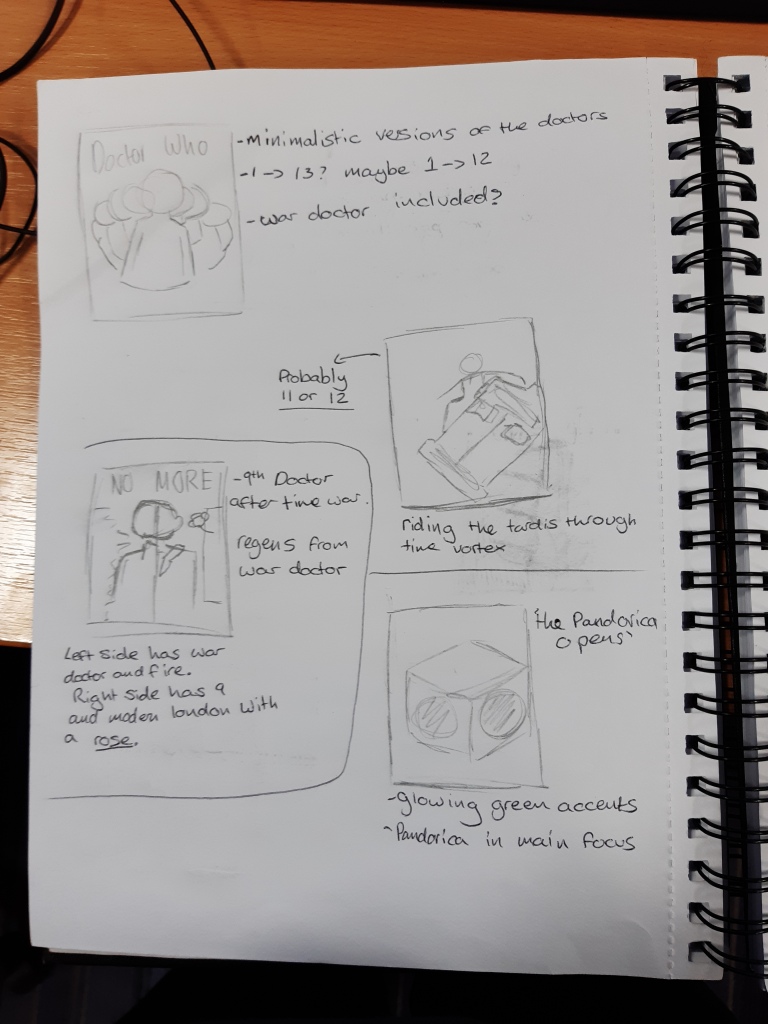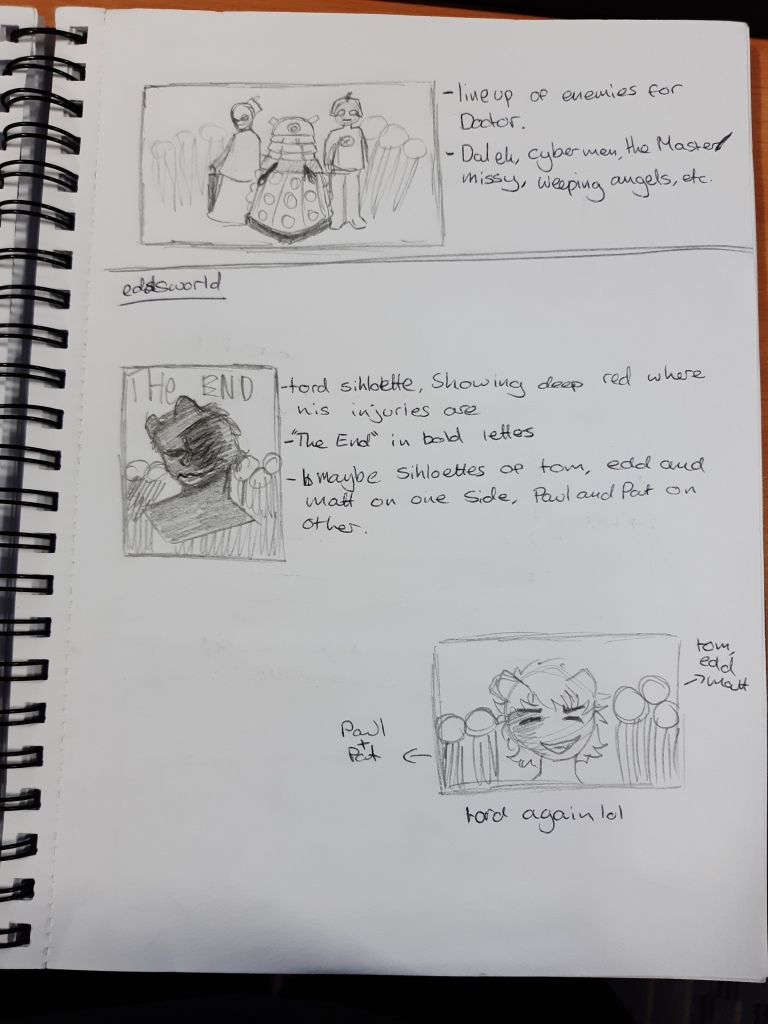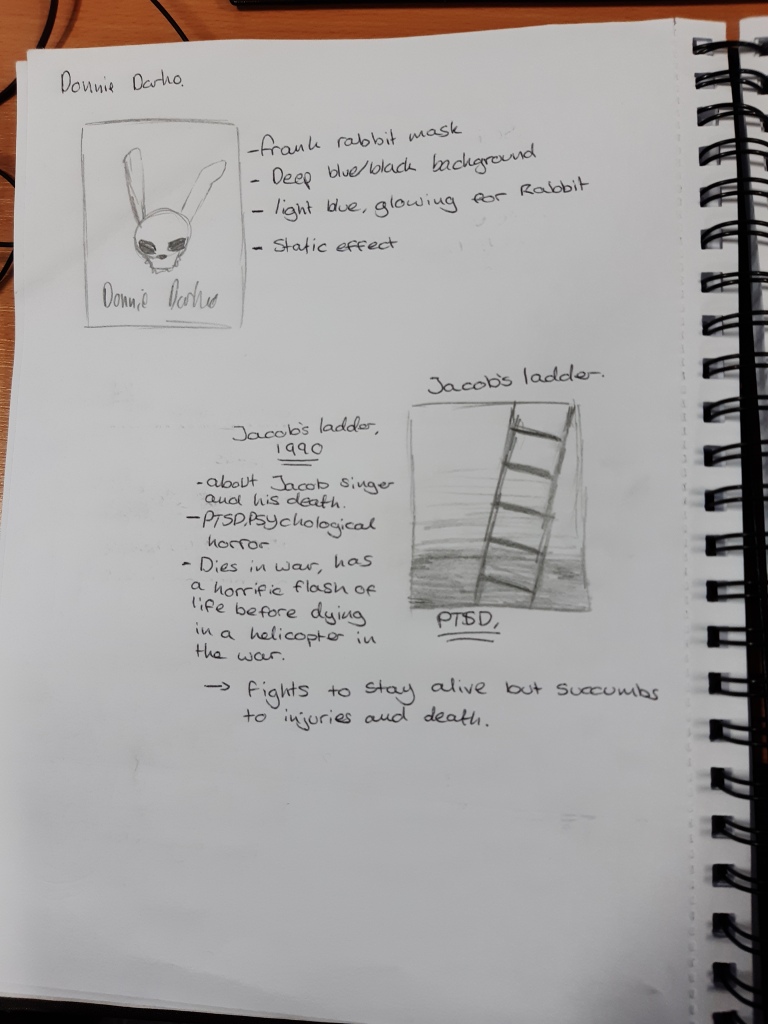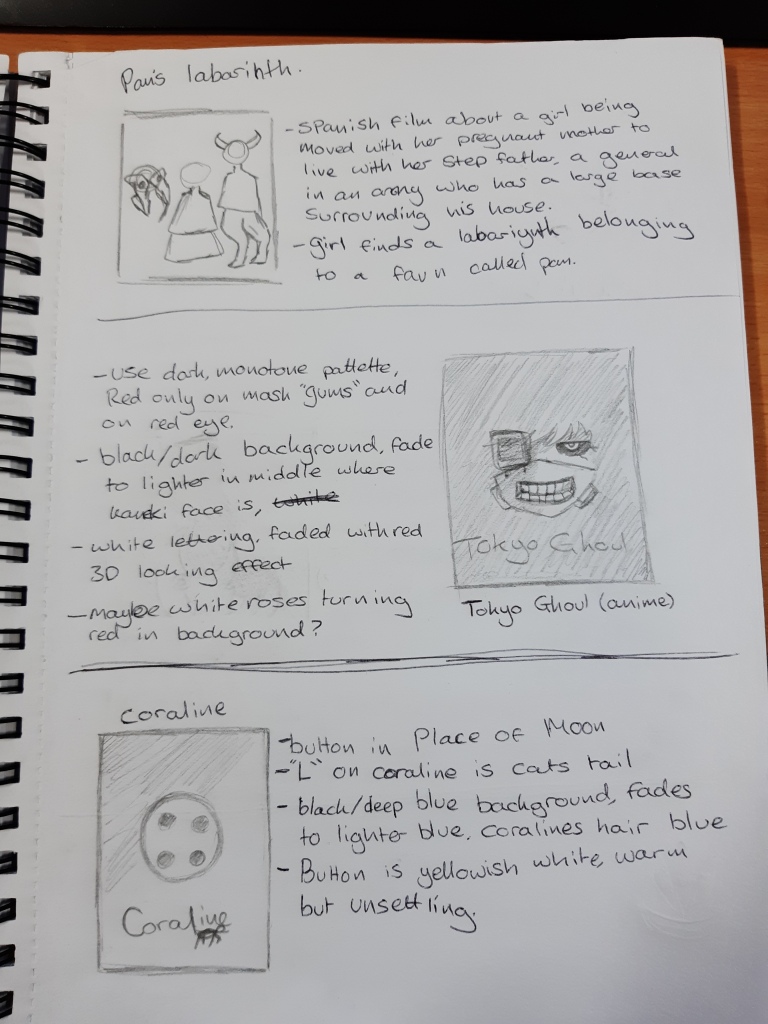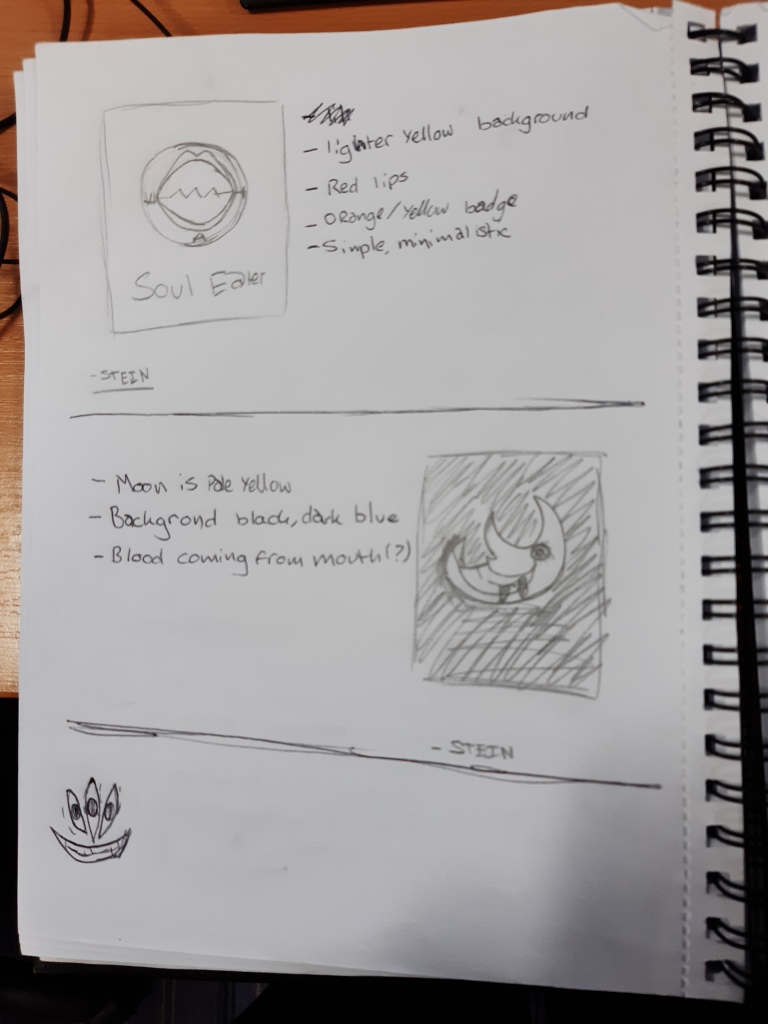Describe and discuss
Primary Research
Primary research is the collection of data done mostly by getting the data yourself. Examples of primary research are collecting data from a target audience directly (surveys, questionnaires, quizzes, etc.), interviewing people either over the phone of face-to-face, visiting taking photos of your own and producing your own sketches if studying a certain thing (art/sculpture). The people who conduct the primary research technically own the data and it normally carried out solely to address a certain problem by studying it in depth.
Secondary Research
Secondary research (sometimes called desk research) is research done using already existing data. The data is already put together and organised. It is normally collected by one party and then put online so others can use it as secondary research. Secondary research is normally stuff that is found through Google, books or other informational pieces, this includes newspapers and tabloids.
Visual Analysis
Visual analysis is when you study a particular piece of art and do an analysis of the art. It uses the elements and principles of visual analysis.
Artist Research
Artist research is a specific type of visual analysis. It is when you study a particular artist. An example of it is saying you are going to study Vincent Van Gogh, not his art but him as an artist.
Contextual Research
Contextual research is researching into how an artist has done something. This can include both paintings and sculptures.
Evaluate and compare the effectiveness
Primary Research Sources
Primary research sources are normally a lot more accurate because that are done by the party and are specifically for whatever purpose that party is using it for.
Secondary Research Sources
Secondary sources can be unreliable and unrelated to the topic such as Wikipedia and other wikias. The internet can be biased but its also the most easily accessible information source.
Describe the following research terms
Bias – A lean for something, normally unfair and prejudiced against another thing.
Reliability – Being trustworthy and reliable, as the word suggests.
Relevance – Something that is appropriate and “important to the matter at hand”.
Authorship – Being the writer/creator of a piece of work/art.
Integrity – Being honest and being undivided.
Peer Review – To have other people evaluate your work.
Harvard Referencing – A type of citation style.
Intension – The content of a concept.
Objectivity – Unbiased.
Validity – How sound your research is, how accurate it is.
Population – A collection of people in a survey.
Ethics – The moral principles that controls a person’s behaviour.
Quantitative – Measuring something on quantity.
Qualitative – Measuring something based on quality.
Triangulation – Division into triangles or measuring using triangles. Getting information from multiple places.
Fake news – Neologism used to refer to fabricated news.
Describe and discuss methods and tools for generating research
Interviews – A conversation where one person asks questions and another person answers.
Focus groups – A group of people put together to take part in a discussion about a product or to give feedback on something.
Surveys – A questionnaire used to study a certain demographic.
Observation – The act of closely observing something.
Books – A type of media, written or printed on pages that are then glued or sewn together.
Journals – A daily record of things, normally a type of newspaper or tabloid.
Internet – Global computer network providing information and communication, consisting of interconnected networks using standardised communication protocols.
Magazines – An occasional publication containing written articles and illustrations/photos. Most often they are on a certain topic (cars, model making, etc.)
Trips – A trip is a education based journey to gather primary research in the form of drawings or photos.
Wikia – A wikia or wiki is a website used to gather information, normally open collaboration.
Hearsay – Information gathered from people that cannot be proven or substantiated
Rumour – A currently circulated story or report of uncertain truth.
Compare the effectiveness of 5 of these methods and tools
Survey
Pros: Can be used to collect data from a lot of people in a short amount of time.
Cons: Can be unreliable with people giving false answers etc.
Wikia
Pros: Very fast way to gather information, lots of context.
Cons: Mostly unreliable data.
Trips
Pros: You gather primary research easily and it is personal to you.
Cons: Can cost a lot to travel to galleries/places.
Books
Pros: Lot of information in one place.
Cons: Heavy and people don’t like carrying them around.
Internet
Pros: Easily accessible information and very quick.
Cons: Sometimes unreliable and can go down. Very modern and new. Current.
Contextual research

Doctor Who is a British science fiction show about a timelord, known as The Doctor, and his occasional companions as they travel through space and time in his spaceship saving civilisations but always coming back to save the earth a few times in between.
The Doctor’s spaceship is known as the TARDIS, Time And Relative Dimension In Space and is a type 40 TARDIS, “borrowed” from his home planet of Gallifrey. It’s exterior is that of a blue police telephone box, a once common site around the UK as emergency telephones and as a place for police to keep crooks while waiting for backup. The TARDIS is bigger on the inside, holding an infinite space within its finite wooden container.
The show itself is a very significant part of the British culture, often being made the butt of jokes by non-British peoples. The classic era, running from 1963 ‘til 1989 is often forgotten about while the run from 2005 ‘til the present day is often the most well-known version, known as the revival era. The revival was produced by BBC Cardiff and has been since 2005.
13 actors have played the Doctors, 14 if you count the War Doctor, played John Hurt. The current Doctor is the only female to ever play the Doctor, Jodie Wittaker. Since the start, it has historically been males who have played the part. The TARDIS has changed a lot too, going from a smaller, more rectangular box to its more defined shape in more recent years. Its colour changes quite drastically too, going from a desaturated blue, through several brighter blues before going back to its more desaturated blue for the revival.
Artist’s research
Louis William Wain, born 5th August 1860, was an artist from England who is most well-known for his art featuring cats. He is most widely known for his anthropomorphic paintings of cats and more recently, his abstract and psychedelic paintings of cats. The paintings are said to have been fuelled by his possible schizophrenia, although this is debated as being Asperger’s Syndrome rather than schizophrenia.
Most of his most recognisable work was done while he was in several mental institutions. He was first sent to Springfield Mental Hospital in 1924, where he only spent a year before being Transferred to Bethlem Royal Hospital, where he stayed until 1930 before being moved to Napsfield Hospital, where he spent the last 15 years of his life comfortable and in peace.
Wain’s schizophrenia has been disputed for years and in 2001, Dr Michael Fitzgerald wrote that “Wain more likely had Asperger’s Syndrome,” and cites that while Wain’s art became more abstract as he got older, his artistic technique and skill never diminished, as is normally expected from someone with schizophrenia. A lot of his later work is said to not even resemble cats, even though a lot of people still consider these pieces part of Wain’s “cat world”
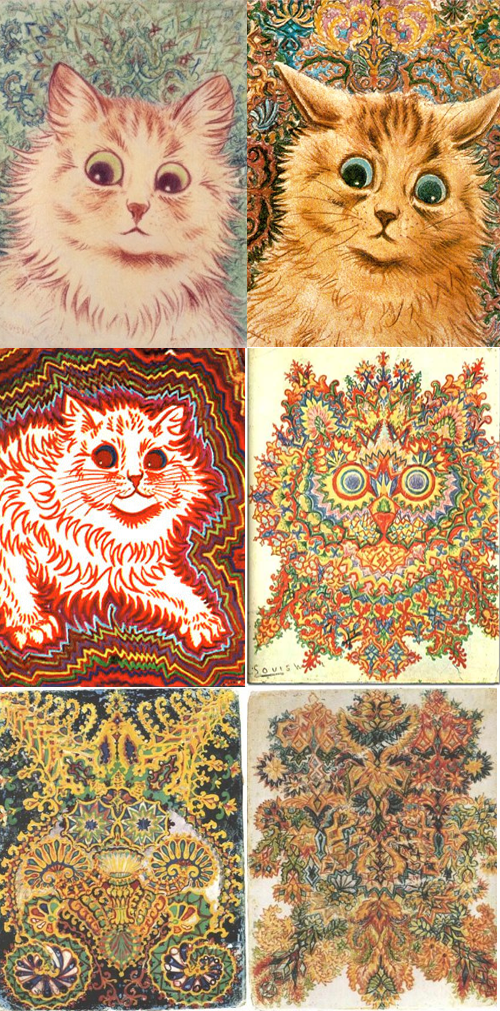
Visual Analysis

This image is one of Louis Wain’s most recognisable pieces. It is a relatively normal looking, light tan/brown cat on a slightly abstract background of green, red and blue grass and flowers.
The line of the picture is very scratchy, showing the fur of the cat in an organic way. The colours of the drawing are dulled and desaturated, using a pale tan and pale yellow/green for the eyes and desaturated greens, blues and reds in the background for the plants. The texture of the piece is very pencil drawn, presumably because the piece was drawing in pencil. The space is dominated by the cat as it is the main subject of the image and takes up most of the picture.
The choice to use duller colours may have been Wain trying to make a more realistic cat but the abstract background could be a hint of what was to come later on in his career. The relatively normal, if not bewildered, looking cat against the abstract and “messy” background gives the cat some normality against the mess of the background.
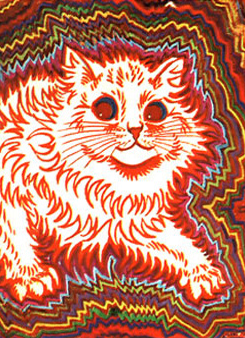
This is one of Louis Wain’s later pieces and as you can see, it is a more abstract and chaotic looking cat portrait.
The colours of this piece are all very piercing, with red being the predominant and outstanding colour. The lines of this drawing/painting are also a lot scratchier yet calculated, showing the progression from Wain’s sketchy pieces to his painted, abstract pieces. The bright colour red also signifies pain, danger and makes the cat stand out heavily against the multicoloured, yet red tinted background. The contrast between this piece and the last piece are significant and show Wain’s mental health through art, showing he felt messier yet calculated and dangerous as he went through the later years of his life.
The choice of brighter, contrasting colours could have been a conscious choice of Wain’s, showing his mental descent but showing he had still a semblance of skill and talent. The geometric shapes are sharp and again, add to the “danger” aspect of this piece. The piece overall is similar to the first but yet, incredibly different.
I chose Louis Wain as an artist because the reason his work looks the way it does highly interests me. The way he uses geometric shapes in his work will probably be reflected in my final piece as I love the way he uses abstract patterns to create something geometric.
Rough sketches and ideas
Developed sketches

Sketch 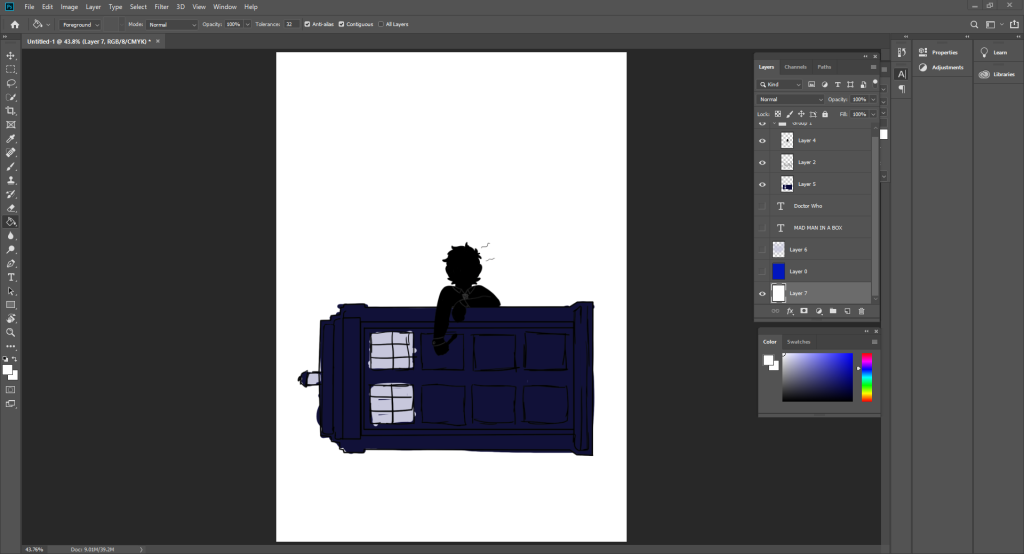
Base colour 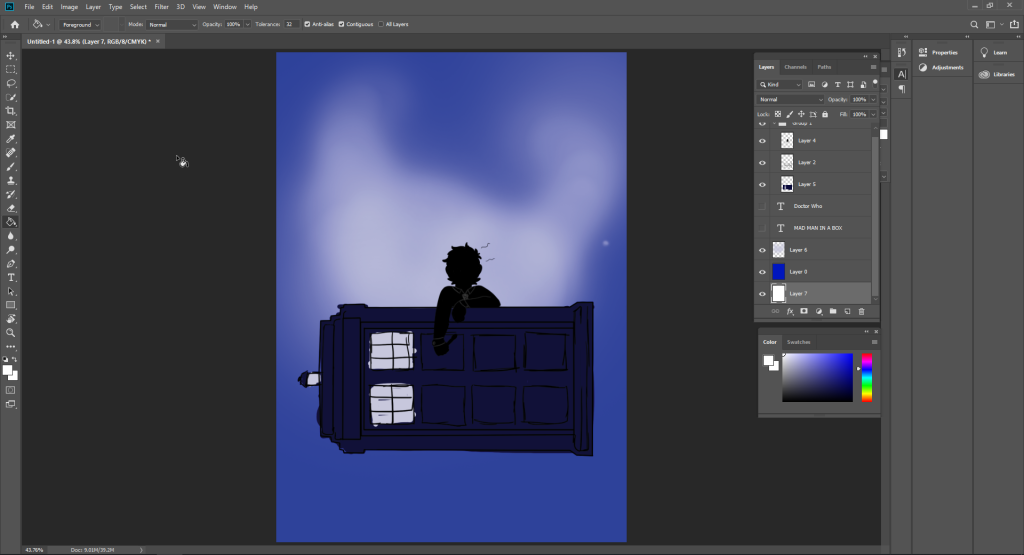
Background colour 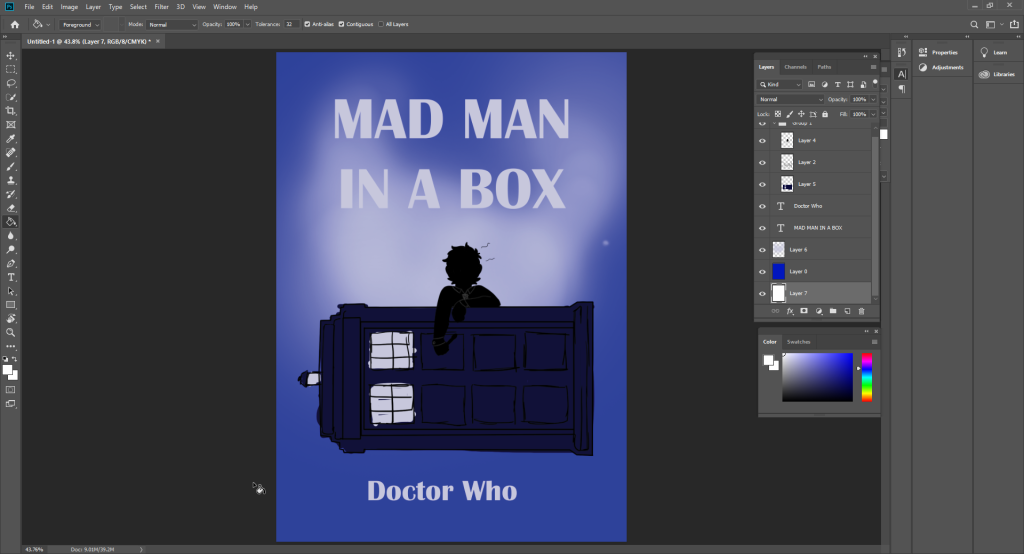
Text added
I chose to develop my Doctor Who idea as I know the most about Doctor Who as a show and feel the “mad man in a box” tagline is one of the most well known taglines from the Matt Smith era. The poster design is based on the first episode Matt Smith played as the Doctor, “The Eleventh Hour”, showing him coming out of the tipped over TARDIS (that he had just crashed into Amy Pond’s garden), dishevelled and high on regeneration energy.
I chose the blue background for the piece because the TARDIS is famously a dark blue colour, changing a few times throughout the years but always being a deep blue shade. I chose to do the poster in a minimalist fashion, keeping it simple by only adding the silhouette of the Doctor and a simplistic looking TARDIS silhouette.
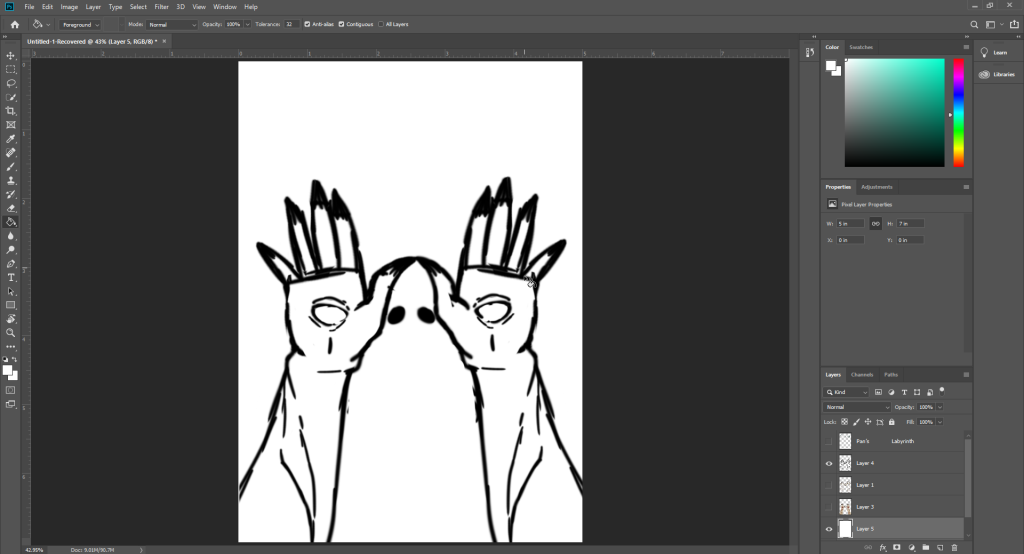
Sketch 
Base colours and line colour 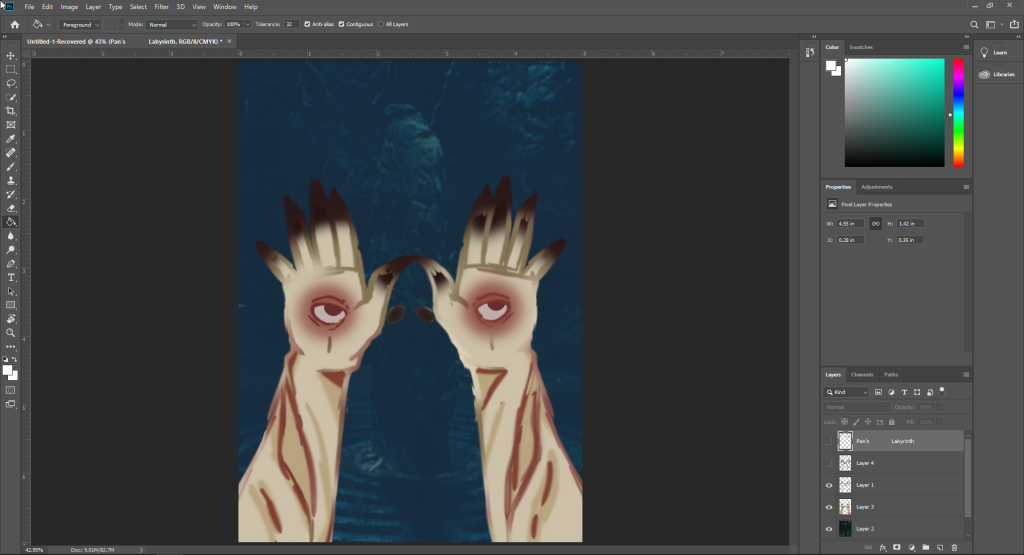
Background added 
Text added
I chose to develop my Pan’s Labyrinth sketch because the film is one of my favourites and I find the concept of it pretty interesting. The poster contains the hands of one of the villains in the movie, known as the Pale Man. The monster has no eyes on his face, but they are on his palms. One of the most notable parts of the movie contains the Pale Man raising his hands up to look at the main character, Ofelia, when she comes into his room.
I chose this scene to use as my poster design because it is easily recognisable and most people know what the monster is, even if they haven’t watched the movie. I chose a deep blue background overlaid with a scene from the movie because it matches the colour scheme of the movie, being a greenish blue colour because of the moss and stone.
Final piece
I chose to go in a different direction for my final piece because I didn’t like my first 2 developed sketches. I went back to my rough designs and chose this one based on the movie being one of my favourites ever made and also the fact it was rather quick do to in such little time.
Evaluation
I did a lot of secondary research on this project but no primary research as there was no primary research to be done in this case. There was a slight bias in my research for more easily accessible websites like Wikipedia and official sources like the BBC website. From my research, I found out that the TARDIS changed its shape and size multiple times over the run of the show.
The designs I made are all inspired by movies that I have enjoyed in the past and some are niche references to parts of the movies. The other ones are based on TV shows and anime that I enjoy, again, with niche references to things that happen in the show/anime. In comparison to previous work, these pieces feel rushed and not very developed but considering my mental state at the time of doing this project, it’s not surprising to me. During the creation of my developed sketches, I changed my mind about it and chose to use my Coraline design as I was rushed for time.
The only typeface I used was block text and a very specific typeface from “Coraline”. The “Coraline” one is done in the style of the actual movie posters, using a cat as the “L” and a button as the “O”, tying it into the movie because buttons and cats are 2 of the most recognisable things in the movie.
The techniques I used in this project aren’t new to me as I do digital art in my free time as a hobby and side job. The final piece for this project would have been better but I am still learning how to use Photoshop. I did learn some new techniques, like how to add a glow effect to things using Photoshop and its brushes. I followed composition skills to make the focal point of the poster the “button moon”, leading down into the title of the movie.
I’m pretty happy with the project, I found it simple to do even with the problems I faced outside of the project. I need to work on my time management for the next project so I get things done on time and don’t have to rush my final piece. This project has different work to other projects because I already have an interest in 2D digital art and the other project we did was in 3D. In comparison to other peer’s work, my work is simplistic but after looking at minimalistic posters made by professionals, I think my final piece is a nice midpoint between minimal and detailed.
Harvard references
Louis Wain Cats: Wikipedia. (2019). Louis Wain’s Cats. Available: https://upload.wikimedia.org/wikipedia/commons/1/12/Louis_wain_cats.png. Last accessed 04/11/2019.
The TARDISes: The Mindrobber. (2019). TARDISes. Available: http://www.themindrobber.co.uk/police-box/TARDISesSm.jpg. Last accessed 05/11/2019.

